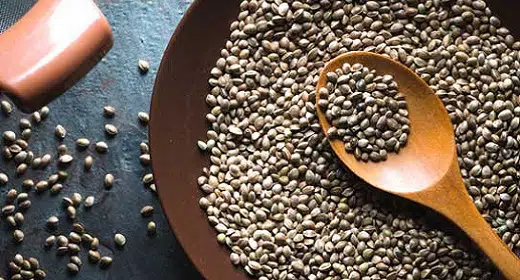by Robert Clarke and Mark Merlin: Cannabis: Evolution and Ethnobotany (University of California Press, 2016) by Robert Clarke and Mark Merlin is a comprehensive, interdisciplinary exploration of the natural origins and early evolution of this famous plant…
highlighting its historic role in the development of human societies. This section details the nutritious benefits of hemp seeds for human consumption.Most commonly, hemp seeds are eaten whole, either raw or parched (roasted) or milled and boiled into porridge, often with rice or another grain. Botanically speaking, Cannabis seeds are actually hard-shelled, single-seeded fruits (called achenes), and the soft, white kernel inside that nourishes either its own embryo or the animal that eats it is actually the “seed.” Many authors mistakenly refer to hemp seed as a “cereal” or “grain” because it is grown as a field crop and provides sustenance similar to true grains (e.g., rice, millet, wheat, barley, rye, etc.), but hemp is actually an oil seed of relatively high protein and low carbohydrate contents. The oil-rich seeds of Cannabis provided another major incentive for its dispersal by early humans.
The nutritional value of hemp seed is quite extraordinary, containing 20 to 25 percent of easily digestible edestin-type proteins, 20 to 30 percent of carbohydrates, and 25 to 35 percent of edible oil as well as about 10 to 15 percent of insoluble fiber, which passes through the digestive tract and thus serves as roughage. The polyunsaturated oil expressed from Cannabis seed has a high content of essential fatty acids (EFAs), while the whole hemp seed also provides an impressive range of minerals including phosphorous, potassium, magnesium, sulfur, and calcium, along with modest amounts of iron and zinc, the latter being an important enzyme cofactor for human fatty acid metabolism. In addition, hemp seed is a fair source of carotene, a precursor of vitamin A. As humans began to keep domesticated animals, hemp seeds and the protein-rich seed cake remaining after expressing hemp seed oil would have been nutritious feeds.
The nutritional value of hemp seed made it a likely protein and oil source wherever early bands of humans encountered fully mature, female Cannabis plants. In addition, there are many nonfood uses for hemp seed oil such as lighting fuel, wood preservative, and soap base. Beyond its fundamental value as a protein and carbohydrate source, the key dietary importance of hemp seeds to early humans resided in their remarkably high levels of EFAs. Omega-3 and omega-6 fatty acids (mostly linoleic and linolenic acids in hemp seed) are “essential” to the human diet because they are required for carrying out vital metabolic life processes, yet we cannot synthesize them from other molecules. True grains and pulses are excellent sources of carbohydrates, and contain significant levels of dietary proteins and oils, but they are almost devoid of EFAs, especially the omega-3 and omega-6 fatty acids vital for human life. Therefore, we must acquire EFAs from other foods besides our basic field crops. Certain fish oils are high in EFAs, along with a few other seed oils such as flax, evening primrose (Oenothera biennis), and borage (Borago officinalis), but hemp is special in that it possesses an ideal ratio of EFAs for human health.









































